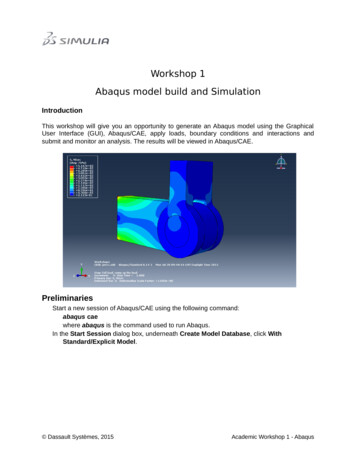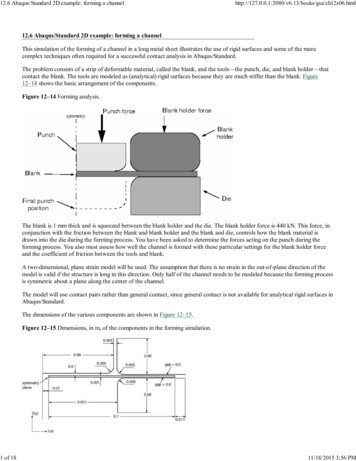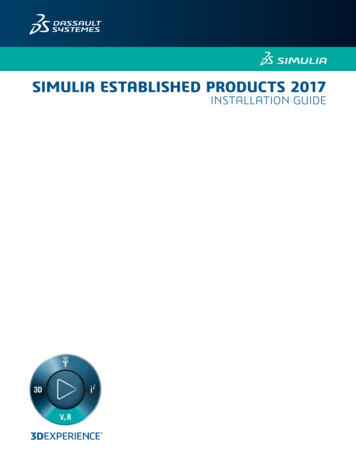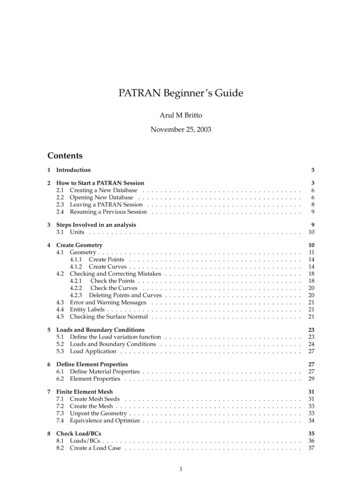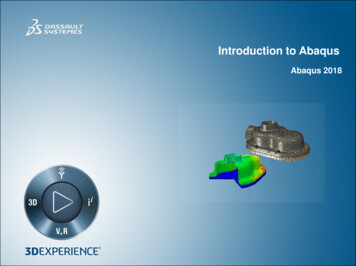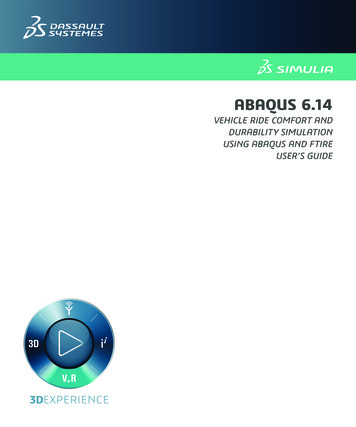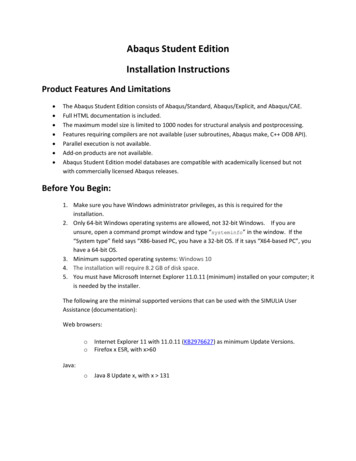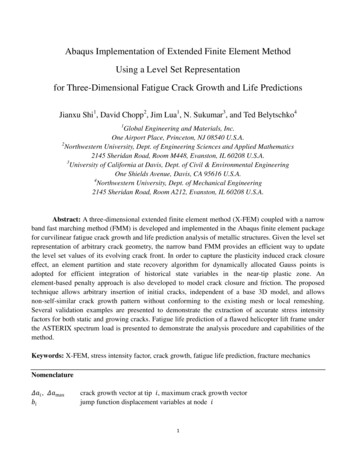
Transcription
Abaqus Implementation of Extended Finite Element MethodUsing a Level Set Representationfor Three-Dimensional Fatigue Crack Growth and Life PredictionsJianxu Shi1, David Chopp2, Jim Lua1, N. Sukumar3, and Ted Belytschko41Global Engineering and Materials, Inc.One Airport Place, Princeton, NJ 08540 U.S.A.2Northwestern University, Dept. of Engineering Sciences and Applied Mathematics2145 Sheridan Road, Room M448, Evanston, IL 60208 U.S.A.3University of California at Davis, Dept. of Civil & Environmental EngineeringOne Shields Avenue, Davis, CA 95616 U.S.A.4Northwestern University, Dept. of Mechanical Engineering2145 Sheridan Road, Room A212, Evanston, IL 60208 U.S.A.Abstract: A three-dimensional extended finite element method (X-FEM) coupled with a narrowband fast marching method (FMM) is developed and implemented in the Abaqus finite element packagefor curvilinear fatigue crack growth and life prediction analysis of metallic structures. Given the level setrepresentation of arbitrary crack geometry, the narrow band FMM provides an efficient way to updatethe level set values of its evolving crack front. In order to capture the plasticity induced crack closureeffect, an element partition and state recovery algorithm for dynamically allocated Gauss points isadopted for efficient integration of historical state variables in the near-tip plastic zone. Anelement-based penalty approach is also developed to model crack closure and friction. The proposedtechnique allows arbitrary insertion of initial cracks, independent of a base 3D model, and allowsnon-self-similar crack growth pattern without conforming to the existing mesh or local remeshing.Several validation examples are presented to demonstrate the extraction of accurate stress intensityfactors for both static and growing cracks. Fatigue life prediction of a flawed helicopter lift frame underthe ASTERIX spectrum load is presented to demonstrate the analysis procedure and capabilities of themethod.Keywords: X-FEM, stress intensity factor, crack growth, fatigue life prediction, fracture mechanicsNomenclature𝛥𝑎𝑖 , 𝛥𝑎max𝑏𝑖crack growth vector at tip 𝑖, maximum crack growth vectorjump function displacement variables at node 𝑖1
𝐵𝑖,con /jump /tipstrain-displacement matrix with respect to continuous/jump/tip ���𝐸𝑓ℎ𝑐𝑟𝐻 𝜉, 𝜂, 𝜁𝑭𝒔𝑭𝒆𝒙𝒕𝒆𝒍𝐾I , 𝐾II , 𝐾IIIglobal-local matrix to compute crack surface displacement jumpsdisplacement variables with respect to branch function 𝑗 at node 𝑖fatigue parameter in the Paris lawtangent matrix in crack surface contact and frictional slidingtangent matrix in material deformationmaterial Young’s modulusbody force in a continuum bodycritical value of crack surface penetration displacementjump enrichment as function of reference coordinates 𝜉, 𝜂, 𝜁nodal reaction force in crack surface contact and frictionequivalent nodal external forces of the elementstress intensity factor in mode I, mode II, and mode III𝐾eqvequivalent stress intensity factor to compute crack growth vector𝛥𝐾𝑖 , 𝛥𝐾maxmagnitude of 𝐾eqv within a load cycle at tip 𝑖, its maximum value 𝐾th 𝐾walker𝑲𝒆𝒍𝑲𝒔𝑚𝑁𝑖 𝜉, 𝜂, 𝜁𝛥𝑁𝑝𝑃1 , 𝑃2 , 𝑃 𝑷𝑅𝑹𝑹𝒆𝒍sℎ , s 𝑖 , 𝑠 𝑆𝑇1 , 𝑇2 , 𝑇 𝑇𝑖 , 𝑇max𝑈𝑖𝑈I , 𝑈II , 𝑈III𝑼𝒆𝒍threshold value of 𝛥𝐾 in fatigue crack growthmodified 𝛥𝐾 in Walker’s equation for fatigue crack growthstiffness matrix of the elementpenalty stiffness matrix in contact and frictional slidingfatigue parameter in the Paris lawtri-linear shape function at node 𝑖accumulated load cycles during an analysis incrementorder of the polynomial used in state variable fittingcut points, midpoint between 𝜓 𝑟 𝜑 0 and element edgespolynomial function used in state variable fittingfatigue load ratio parametertransformation matrix between global-local coordinatesnodal residuals of the elementstate variable at Gauss point, element node 𝑖, and arbitrary locationcrack surface areacut points, midpoint between 𝜓 0 𝜑 0 and element edgestip point corresponding to 𝛥𝐾𝑖 and 𝛥𝐾maxdisplacement variables at node 𝑖local displacement jumps in mode I, mode II, mode III componentsnodal variables of the elementGreek Symbols𝛾parameter in Walker’s equation for fatigue crack growth2
𝜀𝑖𝑗(𝜉, 𝜂, ��𝛹𝑗 𝑟, 𝜃𝛺, Ωmaterial strain tensorelement reference coordinatesangular variable in branch functionsmaterial parameter in plain strain/plain stress calculationsmaterial parameter in plain strain/plain stress calculationsmaterial Possion’s ratiovirtual energy associated with crack surface interactionsmaterial stress tensorcrack surface interaction forcelevel set variable describing signed distance to crack surfacelevel set variable describing signed distance to crack front𝜓 value at node 𝑗 with local polar coordinates 𝑟, 𝜃domain, boundary of domain of a continuum body1. IntroductionFracture and failure is particularly significant in the damage tolerance assessment of advancedmetallic joints, since manufacturing flaws and in-service damage most often manifest themselves as initialcracks. To assess the criticality of an initial flaw and its impact on the residual strength and life, a finiteelement analysis is typically performed for various crack shapes, sizes, and locations. The finite elementmethod poses certain limitations in such analyses since changes in the topology of the crack requireremeshing of the domain. This tends to be a severe restriction and is burdensome for crack growthsimulations in complex geometries. To alleviate the computational burden associated with the insertion ofarbitrary cracks into an finite element model, the extended finite element method (X-FEM) (Belytschkoand Black, 1999; Moes et al., 1999) has provided significant advantages over other approaches such asboundary element methods (Cruse, 1988), remeshing methods (Carter et al., 2000; Maligno et al., 2010),and element deletion methods (Henshell and Shaw, 1975). While the application of the boundary elementmethod can accurately capture the near tip singularities, its extension to elasto-plastic fracture problems isquite awkward due to the use of a domain integration of fictitious body forces to account for thenonlinearity. An element deletion method is easy to implement, but it suffers from a severe dependence ofthe solution on the size and structure of the mesh. An automatic adaptive remeshing scheme can bedifficult to apply to geometrically nonlinear problems involved in contact and friction of a growingcrack, because of the large computational burden. The presence of multiple cracks will make the currentstate-of-the-art remeshing scheme intractable. In X-FEM, the finite element space is enriched with adiscontinuous (jump) function and the near-tip asymptotic functions, which are added to the standardfinite element approximation through the framework of partition of unity (Melenk and Babusk, 1996).Reviews on X-FEM are available in the literature (Karihaloo and Xiao, 2003; Abdelaziz, 2008;Belytschko et al., 2009). Numerous illustrations have demonstrated the key advantage of X-FEM,especially the ability to characterize arbitrarily shaped cracks in finite element methods without remeshing.3
With X-FEM, it is not necessary to reconstruct the finite element mesh as the problem evolves, thereforecompletely eliminating the need for remeshing.Given the many attractive features of X-FEM in performing the damage tolerance assessment andsimulating a curvilinear crack growth path in a complicated 3D geometry, several attempts have beenpromoted to integrate X-FEM with existing commercial FEM solvers. Sukumar et al. (2003)implemented X-FEM in Dynaflow (Prevost, 1983). Nisto et al. (2005) described implementation with anexplicit dynamic code DynELA (Pantale et al., 2004); Bordas et al. (2006) integrated a 3D X-FEMcoupled with level set method into a commercial FEM package I-DEAS; and very recently, Giner et al.(2009) implemented a 2D X-FEM within Abaqus. Indeed, another 2D X-FEM was implemented as anadd-on library kit for Abaqus (Shi et al., 2008) that works seamlessly with the commercial, off-the-shelf(COTS) version of Abaqus/Standard and Abaqus/CAE for automated crack onset and growth. This 2Dversion was applied to fatigue life prediction considering residual stresses in Lua et al. (2008) andcomposite joints reliability assessment in Lua et al. (2009).Driven by emerging needs in accurate and efficient characterization a surface crack in a complicated3D geometry, the existing toolkit has to be extended for the 3D cases. The X-FEM capability wasrecently included in Abaqus Version 6.9, but only for a static crack. For a growing crack, a ghost nodeconcept is employed, instead of nodal degree-of-freedom (DOF) enrichment with discontinuousfunctions, and the crack growth is driven by de-cohesion laws, instead of fracture mechanics criteria.Since the current design and certification of metallic structures conducted by major aerospace and shipindustries are still based on the theory of linear elastic fracture mechanics (LEFM), an accuratecalculation of the stress intensity factors in a growing crack is essential for performing the structuralintegrity and durability assessment. To meet such technical requirements and comply with the currentdamage tolerance design practices and certification guidelines, a discrete fracture mechanics approachhas to be employed for the development of the 3D X-FEM toolkit for a commercial FEM solver.The 3D X-FEM toolkit for Abaqus (XFA3D) has been developed and validated using a suite ofbenchmark problems. The main features of XFA3D include: 1) model preparation and arbitrary insertionof initial cracks that are independent of the base model via Abaqus/CAE; 2) extraction of stress intensityfactors on static or growing crack fronts in metallic structures via the crack tip opening displacement(CTOD) and life predictions for constant or variable fatigue load; 3) accurate extraction of Strain EnergyRelease Rate (SERR) via the modified Virtual Crack Closure Technique (mVCCT) for compositeapplications; and 4) post-processing of the cracked region using Abaqus/Viewer. The criticalcomponents of XFA3D include: the level set representation and updates for a stationary and growingcrack, the penalty approach for interface interactions in crack closure and friction, the element slicingstate recovery algorithm for elasto-plastic fracture problems, and the extraction of fracture driving forcealong the crack front. A summary of the novel developments in these key solution modules of XFA3D isgiven below.In XFA3D, a level set approach along with an enhanced fast marching method is integrated with4
X-FEM to describe the initial crack geometry and track its growth. Stolarska et al. (2001) introduced thelevel set method (Osher and Sethian, 1988) into 2D X-FEM to describe a crack path. The 3D X-FEMcoupled with the level set method was used to simulate non-planar crack growth in Moes et al. (2002)and Gravouil et al. (2002). In this approach a 3D crack is defined by two almost-orthogonal level setsthat are derived from the signed distance functions. One function describes the crack surface in 3D spaceand the other is used to describe the crack front. With this implicit description of the crack front, anarbitrary evolving crack can be captured without explicit geometric representation of the crack. The 3DX-FEM was then coupled with the Fast Marching Method (Sethian, 1999), a more efficient level setalgorithm, to solve single (Sukumar et al., 2003), multiple planar cracks (Chopp et al., 2003), ornonplanar crack growth (Sukumar et al., 2008). In this paper we further improve the level set updatealgorithm by introducing a narrow band concept for efficient update of the level sets for grid points nearthe front, a C(2)-smooth triquintic interpolation of level sets (Chopp, 2001), and a skin of the X-FEMregion to identify the active level set zone for edge crack problems (with an opened crack front curve).These enhancements enable a more robust front tracking in the complicated 3D geometry where crackfront turning, branching or elimination is inevitable during simulations.In order to enhance the robustness and practicability for solving real industrial problems, thenonlinear material behavior especially in the vicinity of the near tip zone has to be considered. In plasticfracture mechanics, Elguedj et al. (2006) utilized the Hutchinson-Rice-Rosengren (HRR) fieldscontaining six enrichment functions and a fixed distribution of Gauss points to obtain accurateprediction of near-tip plastic field for 2D problems. This approach in 3D would require 21 nodal DOFsand a large number of Gauss points per element. In this paper, a slicing scheme proposed by Sukumar etal. (2000) is extended to 3D partially cut elements. If the crack propagates in a new direction, theelement slicing scheme needs to be updated to be coherent with the new crack surface; therefore thelocations of Guass points will change from the previous increment. In our implementation, thesuperconvergent patch recovery (Zienkiewicz et al., 1992), or SPR mapping is developed to recover thematerial states for the new set of Gauss points. Note that the state mapping is only needed for the newpartially cut elements and when the plastic strains are not negligible. In practice, only a confined region(of several millimeters) around an active growing tip needs this state recovery step to account for theeffects from the plastic zone. In other regions only minimal Gauss points are deployed as long as thereare enough Gauss points to avoid weak singularity in the global stiffness matrix. For the current plasticfracture problems under small scale yielding we still use the four branch functions as in X-FEMformulation in LEFM. In fact, if calculation of displacement jumps in CTOD already takes into accountplastic deformations, the K estimates are still accurate for a confined plasticity zone ahead of tips. Toconsider the effects of crack closure, frictional contact, or other interfacial forces, in this paper we alsodevelop an element-based penalty contact approach following the principle of virtual work. Alternativeapproaches have been used, including the LATIN iterative scheme with 2D X-FEM as in Dolbow et al.(2001) the penalty contact with 2D X-FEM as in Khoei et al. (2006) and the Lagrange contact as inKhoei et al. (2009). We opt for a direct contact formulation to avoid new unknowns at the local level.Since a Lagrange approach cannot be easily implemented as a user element algorithm in Abaqus, thepenalty approach appears to be a more rational choice for our implementation.5
The user subroutine interface, scripting-based CAE/GUI customization, and C ODB APIavailable in the Abaqus package are utilized to create a complete toolkit for general fracture and fatigueanalyses. In particular, the user element library (UEL) is used to implement X-FEM elements; the userexternal database (UEXTERNALDB) is used to control the analysis flow, to integrate an embeddedFMM solver, and to store analysis data. In the presence of residual stresses, the initial stress subroutine(SIGINI) is used to introduce an initial stress condition. Isotropic elastic, elasto-plastic, and orthotropicelastic material models are implemented as the Abaqus user materials (UMAT) to be linked with theUEL. Customer material models can be linked using a very similar UMAT interface provided within thetoolkit. Although only the linear, brick element type is fully implemented, its extension to othermaterials or elements can be easily achieved since the framework codes are written in C withmodularization. A basic GUI panel is developed to assist users to prepare X-FEM input files withinAbaqus/CAE. At the end of load increments, analysis results are saved into a separate ODB file usingthe Abaqus C API, so that the users can use Abaqus/Viewer for post-processing needs. Parallel runsand the 64-bit platform (in Linux) are supported to provide access for larger applications. To our bestknowledge, both the stress intensity factor prediction along a growing crack front and the fatigue lifeprediction are not available in the existing package of X-FEM in Abaqus Version 6.9.The paper is organized as follows. A 3D X-FEM element formulation using a B-bar method is givenin Section 2. Sections 3 & 4 describe an implicit representation of crack geometry, a triquinticinterpolation of level sets, and a narrow band FMM for level set updates. In Section 5, a 3D crack fronttracking and fatigue growth control algorithm is introduced. A penalty approach to characterize cracksurface interactions, in particular contact and friction, is given in Section 6. Section 7 presents a slicingscheme to consider both completely cut and partially cut cases. In Section 8, an SPR state mappingalgorithm is described for dynamically allocated material point integration. Section 9 provides a suite ofexample problems for parametric study and accuracy demonstration at sub-component level undermonotonic and cyclic loading. Finally, in Section 10, an industrial example is presented to illustratecrack growth simulation and life prediction in a complex helicopter component under spectrum loading.2. A Modified 3D X-FEM Element Formulation to Avoid Mesh LockingIn this section the 3D X-FEM is developed for both linear and nonlinear materials. In the standardX-FEM formulation the displacements are approximated by𝑢 𝜉, 𝜂, 𝜁 𝑖 𝑁𝑖 𝜉, 𝜂, 𝜁 𝑈𝑖 𝑖 𝑁𝑖 𝜉, 𝜂, 𝜁 𝐻 𝜉, 𝜂, 𝜁 𝑏𝑖 𝑖𝑁𝑖 𝜉, 𝜂, 𝜁𝑗𝛹𝑗 𝑟, 𝜃 𝑐𝑗𝑖(1)where 𝑁𝑖 𝜉, 𝜂, 𝜁 are shape functions; 𝑈𝑖 𝐑3 are nodal displacement parameters for all nodes of thehexahedral element: 1 8; 𝑏𝑖 𝐑3 are jump function parameters at the jump-enriched nodes; and the𝑐𝑗𝑖 𝐑3 𝐑4 are branch function parameters at the tip-enriched nodes. The jump function 𝐻 is6
defined as the sign of level set 𝜑: 1: 𝜑 𝜉, 𝜂, 𝜁 0𝐻 𝜉, 𝜂, 𝜁 1: 𝜑 𝜉, 𝜂, 𝜁 0(2) 1: 𝜑 𝜉, 𝜂, 𝜁 0Note the function 𝐻 𝜉, 𝜂, 𝜁 when 𝜑 𝜉, 𝜂, 𝜁 0 is not well defined; 𝐻 𝜉, 𝜂, 𝜁 1 and𝐻 𝜉, 𝜂, 𝜁 2 is only a convenient designation to evaluate the displacement jumps for a point sittingon the crack surface. The branch functions, noted 𝛹𝑗 , are also defined in a usual way by:𝑟 sinwhere 𝑟 𝜃2,𝑟 cos𝜃2, 𝑟 sin𝜃2sin (𝜃) , 𝑟 cos𝜑 2 (𝜉, 𝜂, 𝜁) 𝜓2 (𝜉, 𝜂, 𝜁) and 𝜃 atan𝜑(𝜉,𝜂 ,𝜁)𝜓(𝜉,𝜂 ,𝜁)𝜃2sin (𝜃)(3). The level set fields 𝜙 {𝜑, 𝜓} in theX-FEM domain are interpolated by the shape functions:𝜙 𝜉, 𝜂, 𝜁 𝑖 𝑁𝑖 (𝜉, 𝜂, 𝜁) 𝛷𝑖 .(4)In our 3D X-FEM elements the B matrix is modified from the standard formulation to be fullycompatible with Abaqus solid elements. The modified B matrix is also known as the B-bar method(Nagtegaal et al., 1974), since the actual volume changes at the Gauss points are replaced by the averageof volume change over the entire element. The modified strain-displacement relation helps to preventmesh locking and therefore provides an accurate solution for highly incompressible cases. Using themodified B-matrix also ensures the derived X-FEM, if not cut by a crack, is fully compatible with thelinear, fully integrated element in tiongradient: 𝛥𝑢 𝑥 𝑁𝑖 𝜉𝑖 𝜉 𝑥 𝛥𝑈𝑖 𝑖𝑁𝑖,𝜉 𝐽 1 𝛥𝑈𝑖 , where 𝐽 1 is the inverse of the transformation matrix 𝐽. In theB-bar method we estimate the volumetric average of the terms in the deformation gradient operator, or1𝑁𝑖,𝜉 𝑉𝑒𝑉𝑒𝑁𝑖,𝜉 𝑑𝑣 𝑁𝑖,𝜉 𝜉 0 . If one denotes:𝑁𝑖,𝜉 (𝑁𝑖,𝜉 𝜉 0 𝑁𝑖,𝜉 )/3,(5)then the modified B-matrix for the unenriched nodes takes the form:𝐵𝑖,con 𝐽 1𝑁𝑖,𝜉 ��𝑁𝑖,𝜂 �,𝜁𝑁𝑖,𝜁 𝑁𝑖,𝜁0𝑁𝑖,𝜉𝑁𝑖,𝜂where the derivatives of the shape functions are readily available.7(6)
For the jump-enriched nodes the extra terms of the B-matrix are simply 𝐵𝑖,jump 𝐻𝐵𝑖,con , becausethe derivative of 𝐻 is zero. Note the jump function, 𝐻, is multiplied term by term in forming 𝐵𝑖,con , sothe B-matrix is:𝐵𝐽 [𝐵𝐽 ,con 𝐵𝐽,jump ](7)where the subscript 𝐽 indicates the nodes with jump enrichment.For the tip enriched nodes the extra terms of the B-matrix are:𝐵𝑖,𝑗 ,tip 𝐽 1(𝑁𝑖,𝜉 𝑁𝑖,𝜉 )𝛹𝑗 (𝑁𝑖 𝑁𝑖 )𝛹𝑗 ,𝜉𝑁𝑖,𝜂 𝛹𝑗 𝑁𝑖 𝛹𝑗 ,𝜂𝑁𝑖,𝜁 𝛹𝑗 𝑁𝑖 𝛹𝑗 ,𝜁𝑁𝑖,𝜉 𝛹𝑗 𝑁𝑖 𝛹𝑗 ,𝜉(𝑁𝑖,𝜂 𝑁𝑖,𝜂 )𝛹𝑗 (𝑁𝑖 𝑁𝑖 )𝛹𝑗 ,𝜂𝑁𝑖,𝜁 𝛹𝑗 𝑁𝑖 𝛹𝑗 ,𝜁𝑁𝑖,𝜉 𝛹𝑗 𝑁𝑖 𝛹𝑗 ,𝜉𝑁𝑖,𝜂 𝛹𝑗 𝑁𝑖 𝛹𝑗 ,𝜂𝑁𝑖,𝜁 𝛹𝑗 𝑁𝑖 𝛹𝑗 ,𝜁0𝑁𝑖,𝜂 𝛹𝑗 𝑁𝑖 𝛹𝑗 ,𝜂𝑁𝑖,𝜉 𝛹𝑗 𝑁𝑖 𝛹𝑗 ,𝜉0𝑁𝑖,𝜁 𝛹𝑗 𝑁𝑖 𝛹𝑗 ,𝜁(𝑁𝑖,𝜁 𝑁𝑖,𝜁 )𝛹𝑗 (𝑁𝑖 𝑁𝑖 )𝛹𝑗 ,𝜁0𝑁𝑖,𝜉 𝛹𝑗 𝑁𝑖 𝛹𝑗 ,𝜉𝑁𝑖,𝜂 𝛹𝑗 𝑁𝑖 𝛹𝑗 ,𝜂(8)where the subscript, 𝑗 1 4, represent the branch functions. To obtain the derivatives of the branchfunctions, the chain rule is used, or 𝛹𝑗 ,𝜉 𝛹𝑗 ,𝑟 𝑟,𝜉 𝛹𝑗 ,𝜃 𝜃,𝜉 , with 𝑟,𝜉 𝑟,𝜑 𝜑,𝜉 𝑟,𝜓 𝜓,𝜉 and 𝜃,𝜉 𝜃,𝜑 𝜑,𝜉 𝜃,𝜓 𝜓,𝜉 . The derivatives of the branch functions 𝛹𝑗 ,𝑟 and 𝛹𝑗 ,𝜃 are listed below:𝛹1,𝑟 21𝛹2,𝑟 21𝛹3,𝑟 21𝛹4,𝑟 𝑟;𝛹1,𝜃 ;𝛹2,𝜃 sin 𝜃 ;𝛹3,𝜃 sin 𝜃 ;𝛹4,𝜃 2𝑟2cos𝑟2𝑟2𝜃sincos2𝜃(9)2𝜃2sin 𝜃 𝑟 sin𝜃sin2𝜃2sin 𝜃 𝑟 coscos 𝜃𝜃2cos 𝜃The transformation derivatives from (𝜑, 𝜓) to (𝑟, 𝜃) are:𝑟,𝜑 𝜑𝑟, 𝑟,𝜓 𝜓𝑟𝜓𝜑, 𝜃,𝜑 𝑟 2 , and 𝜃,𝜓 𝑟 2 .(10)From Eqn (4), the level set derivatives 𝜑,𝜉 and 𝜓,𝜉 can be interpolated in terms of shape functionderivatives, namely:𝜑,𝜉 𝑖𝑁𝑖,𝜉 𝛷𝑖 , 𝜑,𝜂 𝑖 𝑁𝑖,𝜂𝛷𝑖 , 𝜑,𝜁 8𝑖𝑁𝑖,𝜁 𝛷𝑖 , and
𝜓,𝜉 𝑖𝑁𝑖,𝜉 𝛹𝑖 , 𝜓,𝜂 𝑖 𝑁𝑖,𝜂𝛹𝑖 , 𝜓,𝜁 𝑖 𝑁𝑖,𝜁𝛹𝑖 .(11)Finally the B-matrix for tip-enriched nodes can be written as:𝐵𝑇 [𝐵𝑇,con 𝐵𝑇,1,tip 𝐵𝑇,2,tip 𝐵𝑇,3,tip 𝐵𝑇,4,tip ](12)where 𝑇 denotes the nodes with tip enrichment. The strain vector defined as𝜺 {𝜀11 , 𝜀22 , 𝜀33 , 𝜀12 , 𝜀13 , 𝜀23 } is evaluated by:𝜺 𝑘 1,8 𝐵𝑘 𝑈𝑘(13)where 𝑈𝑘 is the vector of all active unknowns at the node 𝑘. Note the dimensions of the B-matrix forregular nodes is 6 3, for jump-enriched nodes is 6 6, and for tip-enriched nodes is 6 15. Thedimensions of the 𝑈 vector for regular nodes is 3 1, for jump-enriched nodes is 6 1, and fortip-enriched nodes is 15 1. For an incremental formulation, the strain increments are expressed as:𝜟𝜺 𝑘 1,8 𝐵𝑘 𝛥𝑈𝑘 and the stresses for a small deformation problem can be written as: 𝜟𝝈 𝝈𝟎 𝑫𝜟𝜺, where D is the tangent material matrix.The remaining part of the element formulation is quite straightforward. We assemble the B-matricesfor the element operator: 𝑩 [𝐵1 𝐵2 𝐵8 ] where the dimension of the 𝑩 matrix is6 total active DOFs of this element. Thus the element stiffness matrix is:𝑲𝒆𝒍 𝑩 𝑫𝑩 d𝑥 d𝑦 d𝑧 𝛼 𝑖 (𝑩 𝑫𝑩)𝛼𝑖𝑤𝛼𝑖 𝐽𝛼(14)where 𝐽𝛼 is the volume of sub-element 𝛼 ; 𝑤𝛼𝑖 is the local weight at sampling point 𝑖 of thesub-element; and (𝑩 𝑫𝑩)𝛼𝑖 stands for the matrix evaluated at that sampling point. The element RHSvector is given by:𝑹𝒆𝒍 𝑩 𝝈 d𝑥 d𝑦 d𝑧 𝛼 𝑖 (𝑩 𝝈)𝛼𝑖𝑤𝛼𝑖 𝐽𝛼(15)where 𝝈 is the stress vector 𝝈 {𝜎11 , 𝜎22 , 𝜎33 , 𝜎12 , 𝜎13 , 𝜎23 }. In Abaqus the Newton-Raphson iterationis used to resolve the nodal residuals:𝑲𝒆𝒍 𝜟𝑼𝒆𝒍 𝑭𝒆𝒙𝒕(16)𝒆𝒍 𝑹𝒆𝒍𝒆𝒙𝒕Here the vector of nodal unknowns 𝜟𝑼𝒆𝒍 [𝑈1 𝑈2 𝑈8 ] and 𝑭𝒆𝒍 is the vector of nodal externalloads.3. Implicit Crack Representation and Initialization of the Level Set RepresentationIn the level set representation, a 3D crack is defined by two orthogonal level set fields. One of themdescribes the crack surface {x: (x) 0 and (x) 0}, and the second is used to describe the crack front{x: (x) 0 and (x) 0}. This implicit description of the crack surface by level sets can be illustratedin Figure 1.9
Figure 1: Illustration of the crack surface function and the crack frontfunction .The values of the two functions are generated and maintained on a narrow band of grid points around thecrack surface and tip, and are used to obtain not only geometric information about the location of thecrack, but also provides a local coordinate system that is used to generate the enrichment functions usedin the X-FEM formulation. This is accomplished by also requiring that always represents the signeddistance to the extended crack surface, while gives the signed distance to the surface that intersects thecrack surface at the crack front and is also orthogonal to the crack surface.To initialize the values for and , we start by initializing on the gridpoints of the elements thatare cut by the extended initial crack surface (see circled gridpoints in Figure 2). For a given gridpoint, x,the value of (x) is the minimum distance between x and the crack surface elements. Assuming y is thepoint on a particular element where the minimum distance is obtained, and n is the unit normal to theelement containing the point y, (x) is initialized by: ( x) x y n(17)Once (x) is computed for each gridpoint on an element cut by the crack surface, the remainder of thedomain, up to the narrow band limit (see the square points in Figure 2), is initialized by using the FastMarching Method to extend the values out to a distance , the width of the narrow band around thecrack surface as illustrated in Figure 2.Figure 2: Illustration of the narrowband, in gray, of points around the crack surface,in cross-section, where the FMM mesh maintains signed values. The circled pointsare where the initialized values are computed directly and the squared points arewhere the values are computed using the FMM.In this case, the values are extended 1(18)in the remainder of the narrowband outside the directly-computed points.distance function, radially outward from the crack surface.This extends , as the signed Once is computed, the crack tip function, , can now be determined so that for the crack frontgiven as a sequence of points ym, (ym) 0, and is a signed distance function such that (ym ) (ym ) 0 . Let y(s) be a parameterization of the crack tip, which interpolates the points ym ,then (x) is computed by: (xijk ) x y(s) ijkdyds n dyds n(19)10
where n is the normal to the crack surface, the point y(s) is the point on the crack tip nearest to x, anddyds n gives the normal to the isosurface (x) 0. Note the values of and are set only within aspecified bandwidth, , from the crack surface. Thus, these values are set only for grid points x such that (x) and (x) .4. Update of the Level Set RepresentationThe first step in updating the level set functions and is to reconstruct the crack front as aone-dimensional parameterized curve from the intersection of the two isosurfaces, {x : (x) 0} {x : (x) 0}. To do this, we start by locating a voxel that is cut by both isosurfaces, which is easilyidentified by a box that contains a change of sign in the values of both and at the gridpoint vertices.Next, the point in the center of this voxel is used as an initial condition for an iterative projection ontothe intersection. The iteration is given byx n 1 p(x n ) p(x n ) q(x n ) q(x n )(20)where p(x) is the triquintic interpolant for (x), and q(x) is the triquintic interpolant for (x). If theiteration takes xn 1 out of the voxel, then the interpolants for the new voxel are used on subsequent iterations until it converges. Typically, only two or three iterations are required to achieve convergence,when p(xn 1) 0 and q(xn 1) 0. The solution of this iteration is set to be y0, the first point on thecrack tip parameterization.Given the point ym, we find ym 1 by first findingx ym p(ym ) q(ym ) p(ym ) q(ym )(21)where is the preferred approximate spacing between ym and ym 1. The point y* is then projected onto{x : (x) 0} {x : (x) 0} using Eqn (20) to give ym 1. This continues until we close the loop by finding a point ym 1 such that ym 1 – y0 , or ym 1 is outside the computational domain. In the lattercase, the crack tip is treated as an edge crack, and the crack tip must be completed by starting at y0 andthen proceeding backward, i.e. using - in place of in Eqn (21) until the crack tip again exits the1domain. For our tests, we used 2 min( x, y, z) , where x, y, z, are the space step sizes of themesh in each of the coordinate directions.Once the crack tip has been parameterized, we then update and on all grid points within aspecified bandwidth distance from the crack front by direct calculation using a similar formulation tothat used in Sukumar et al. (2008) except that only the narrow band region near the front is updated. Inthis case, given a gridpoint x, we first locate the point y on the crack front nearest to x using the11
parameterized representation. Let F(y) be the crack front velocity at the point y, then the new value for is given by (x) F x y F(22)Once is computed, is given by (x) (F ) F x y F t(F ) F(23)Note that the above formulas do not require the previous value to be valid, hence even if the point x mayhave not been in the narrow band before, it can still be easily updated. The bandwidth chosen must be large enough so that after the crack front has advanced, there are enough grid points around the newcrack front location in order to populate all the data required for the triquintic interpolant around thecrack front. This includes any voxel cut by the crack surface as well as a 6x6x6 array of gridpointscentered around that voxel. Thus, the bandwidth chosen will depend on the grid size, time step size, andmaximum tip speed.5. 3D Crack-Front Tracking and Growth Control ModuleIn our Abaqus implementation, a key module is what used to interpolate data between the AbaqusFEM solver and the embedded level set representation. This module tracks the crack front and estimatesthe crack front velocity vectors based on the crack tip driving force and the fatigue law. The Abaqus usersubroutine, UEXTERNALDB, is used to manage nonlocal data that cannot be accessed or updatedthrough UEL’s functional interface. These data include the nodal level set variables, element integrationscheme, sub-element mesh for subsequent visualization, Gauss point coordinates, and strain/stressvariables at Gauss points. They cannot fit in the existing Abaqus facilities due to the followingconsiderations: 1) the level set variables are initialized and updated by coupling the separate level setrepresentation, not within the user element subroutine; 2) the element slicing scheme and integrationpoint location
(2009) implemented a 2D X-FEM within Abaqus. Indeed, another 2D X-FEM was implemented as an add-on library kit for Abaqus (Shi et al., 2008) that works seamlessly with the commercial, off-the-shelf (COTS) version of Abaqus/Standard and Abaqus/CAE for automated crack onset and growth. This 2D
